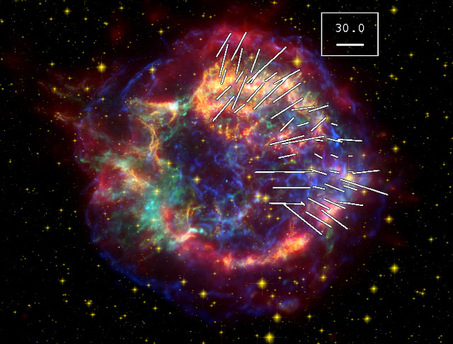Dust from star explosions
Iron needles in Supernovae?
 © Loretta Dunne, University of Nottingham; X-ray: NASA/CXC/SAO; Optical: NASA/STScI; Infrared: NASA/JPL-Caltech. |
Cassiopeia A supernova remnant. The overlaid lines indicate the polarized signal from cold dust within the remnant with the strength marked by the length of each line. The temperature of this dust is around -250°C.
The interstellar dust found by Loretta Dunne from the University of Nottingham is unusual. The polarization signal from the supernova dust is the strongest ever measured anywhere in the Milky Way. “It is like nothing we’ve ever seen” said Loretta Dunne. “It could be that the extreme conditions inside the supernova remnant are responsible for the strong polarized signal, or it could be that the dust grains themselves are highly unusual” Professor Rob Ivison comments further.
The polarization of the radiation follows the magnetic field of Cassiopeia A, which is evidence for the theory that the dust actually belongs to the remnants of the supernova and is not just in the foreground or background. However the radiation and the polarization of the particles is stronger than expected from calculations. A possible explanation, which will be presented in the journal "Monthly Notices of the Royal Astronomical Society" is that the dust particles are actually little needles out of graphite or iron.
This could have major consequences for our understanding of the cosmic microwave background — one of the most important building blocks of the Big Bang model of our Universe and in the end help us to understand the history of the universe a little better.
Rainer Kayser is a journalist in Hamburg
Dust from star explosions
Iron needles in Supernovae?
 © Loretta Dunne, University of Nottingham; X-ray: NASA/CXC/SAO; Optical: NASA/STScI; Infrared: NASA/JPL-Caltech. |
Cassiopeia A supernova remnant. The overlaid lines indicate the polarized signal from cold dust within the remnant with the strength marked by the length of each line. The temperature of this dust is around -250°C.
The interstellar dust found by Loretta Dunne from the University of Nottingham is unusual. The polarization signal from the supernova dust is the strongest ever measured anywhere in the Milky Way. “It is like nothing we’ve ever seen” said Loretta Dunne. “It could be that the extreme conditions inside the supernova remnant are responsible for the strong polarized signal, or it could be that the dust grains themselves are highly unusual” Professor Rob Ivison comments further.
The polarization of the radiation follows the magnetic field of Cassiopeia A, which is evidence for the theory that the dust actually belongs to the remnants of the supernova and is not just in the foreground or background. However the radiation and the polarization of the particles is stronger than expected from calculations. A possible explanation, which will be presented in the journal "Monthly Notices of the Royal Astronomical Society" is that the dust particles are actually little needles out of graphite or iron.
This could have major consequences for our understanding of the cosmic microwave background — one of the most important building blocks of the Big Bang model of our Universe and in the end help us to understand the history of the universe a little better.
Rainer Kayser is a journalist in Hamburg





